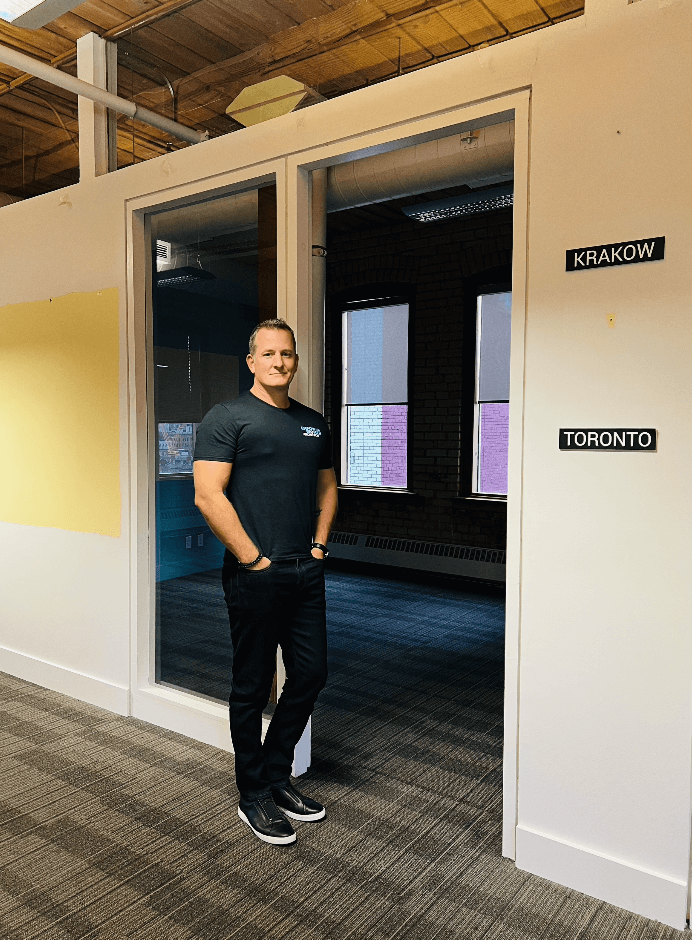#EmbraceChange isn’t just a hashtag. It’s one of our battle-tested core values, particularly as we reinvent the way our growing team of 160 highly skilled professionals build modern tech solutions.
We are now using “remote-first” as our organizational work strategy at Architech, which makes working remote the primary option for all our staff. For many organizations, shifting to remote work was an urgent necessity to continue operating amid the early days of the pandemic. At Architech, we’ve realized it represents a long-term opportunity to further our mission of building a better future.
We want that future to include:
- Greater flexibility to support an engaged employee experience;
- The ability to continue developing an inclusive organization that can welcome and empower a diverse range of talented people; and
- Driving greater sustainability in how we treat our planet.

What does “remote-first” mean for us?
Remote-first means none of our team are regularly required to perform their jobs from a centralized office - permanently. We’ve given up our offices in Toronto and Kraków. Our team will work from home most of the time, but can also choose from co-working spaces, hotels, coffee shops, family homes, and wherever else makes sense for any given day.
As our founder, closing our physical offices has been particularly sentimental. I remember vividly the excitement (and even pride) as we opened each one, my hopes and dreams tied up in picking locations and furniture.
Since our inception back in 2004, our culture has been predicated on face-to-face interactions in office settings. Whether this was onsite at client offices or in our own as we moved from a small footprint in downtown Toronto to offices in two countries, our clients expected “bums in seats” and our teams flourished in a variety of richly collaborative environments.
Remote is not the same. I’ll be the first to admit it. When it makes sense to hold an in-person meeting, however, we’re making it easy to arrange. Our team can also work abroad periodically, something we expect will grow in popularity as the pandemic simmers down.

5 pillars that built our business case for a remote-first policy
As we look to a post-pandemic reality, we have taken the time to re-envision our working model. Businesses of all types, including our clients and competitors, are looking at remote work as a part of their future. The world has changed, and we believe trying to return to the way it was before would be foolish.
This is about heightened intension, optionality, and flexibility.
We are adopting a remote-first work policy based upon considerations such as:
1. Team feedback: In a recent global study on Business Insider, fewer than half of survey respondents in most countries said their employers asked them about their preferences for their post-pandemic routine.
At Architech, we saw the idea of remote-first as an experiment, an adventure, but also a unique opportunity to truly listen to our teammates.
We took an internal survey of our own, and the results were overwhelming. In fact, 88% of our team members are satisfied with our current remote work arrangements. Nearly as many, or 83% of our team members, said they prefer remote work or less than one day per week in the office.


2. Talent recruiting and retention: According to a survey conducted by TalentLMS and Workable, 72% of technology professionals are thinking about quitting their job over the next 12 months. The issues not only include traditional challenges like salaries, but lack of flexibility, which was cited by 40%.
In a remote-first environment, we now have access to a vast pool of prospective employees. This can be a crucial advantage in terms of attracting and retaining talented people. Nearly half of our team lives outside of our current Toronto and Kraków hubs, and this will continue to grow as we hire increasingly outside these areas.
As a result, most of our team enjoy the hours saved on their commute, and many have already moved from downtown city centres to surrounding small towns. There is no doubt that we have all come to appreciate the benefits of working much of our time from home, including reduced commute time/costs and better life balance.
We are reallocating a sizeable portion of the cost savings from going remote first to our team in terms of modern benefits, travel, home office upgrades, and social events. Employees also enjoy financial savings in the flexibility to live in lower priced cities, reduced commute and child-care costs, and tax advantages from home office expenses.

3. Diversity and equity: The most recent Women in the Workplace 2021 study from consulting firm McKinsey found that, for every 100 men promoted to manager, only 86 women are promoted. In the past year, meanwhile, one in three women has considered leaving the workforce or downshifting their career—a significant increase from one in four in the first few months of the pandemic.
Remote work benefits women who traditionally take on the majority of childcare responsibilities. We are providing opportunities for women in leadership and flexibility around work arrangements. Our promotion rate for women is also on par with the promotion rate for men, and half of our management team is made up of women today.
Remote work also increases accessibility and has resulted in a higher labor force participation rate for people with disabilities.
Hiring more globally also increases our team diversity, a needed ingredient for tech innovation. This past fall, for instance, tech publisher Wiley conducted a U.S. survey on diversity within the tech sector in which 64 percent of participants in the survey said they believe minorities are discriminated against in the tech recruitment process. This has to change, and now. At Architech, we are proud that 57% of our workforce identify as people of the global majority .

4. Greater sustainability and environmental stewardship: The recent COP26 summit hosted by the United Nations made it clear that we all have a responsibility in responding to what one official called a “code red for humanity.”
Fortunately, there is plenty of data to suggest that remote work could help tackle some of the biggest threats to the Earth’s natural resources. According to the Environmental and Energy Study Institute, for instance, 40% of carbon emissions come from buildings like office towers. A study from FlexJobs and Global Workforce Analytics, meanwhile, found that 3.9 million people working from home at least half time would reduce greenhouse emissions by an amount equivalent to removing 600,000 cars for an entire year. Architech’s work from home allowance helps here by making it easy for our team members to choose green energy such as Bullfrog Power.
I spoke with Rosie, Architech’s Sustainable Development Lead. She said using eco-friendly mailers, switching our wellness budgets to allow eco-friendly home devices, changing where and how we order lunches, it all has an impact and it’s great to be able to keep that integrity.
“Switching to remote really forced us to look at what we are doing with intent, try new things, and do more for the environment,” she added.

5. Improved Business Continuity and Adaptability: The pandemic has highlighted the need to continue operations seamlessly without disruption. It is entirely possible that covid continues as a global threat, and that additional variants or other health-related threats surface over time. A remote-first policy helps to ensure this business continuity in the face of uncertainty. Hiring staff on a more global basis avoids concentrations in just a couple cities or countries.
A remote-first approach provides the highest level of agility. We avoid locking into long and costly office lease agreements. Office space is no longer a constraint to our growth.
Building a better future
We were fortunate in that our office in Poland had been operating for five years before the pandemic began. That gave us a head start on a fully distributed working model and allowed us to adapt seamlessly once it became necessary across the board. We had also invested heavily in our culture, new hire onboarding, multi-office collaboration, modern digital tools, and a delivery process that was prepped and ready for remote work. The past 18 months have simply been a forced experiment for how to make it all work well.
I’m thrilled that our client project results, productivity, and team morale have been outstanding. We’ve had fun and stayed connected with hikes, kayaking, and other outdoor socials, as well as a wide range of informal and structured virtual events. Our future is warm and inviting with many opportunities to remain connected and forge new friendships across our company, clients, and communities.
We were also fortunate not to be constrained by commitments to fancy offices like many of our competitors. I am grateful that we can be agile and do the right thing for our team rather than trying to convince them to return to spaces in which they don’t want to be. Our teammates want more balance, purpose, and flexibility. We’ve heard them, which is why there is now a Remote Culture committee that will shape the future of how we work and connect. It will also play a role in guiding the way we develop our benefits and culture as the pandemic, and our company, evolves.

That said, we recognize that we need to purposefully design our workflow and communications to prioritize varying employee locations. Erica Dhawan said it best in her book Digital Body Language: How to Build Trust and Connection, No Matter the Distance: body language hasn’t disappeared behind a screen, it has transformed.
That means we need to recognize signals that can indicate empathy, inclusion and psychological safety. It could be as simple as using a pause on a video call to let people absorb information rather than rushing to fill the silence. It can be creating policies around which digital channels are best for sharing for brief updates versus in-depth communication. Promoting accessibility — through captions on video calls, for instance — should become the new best practices. Marima, Architech’s Head of Business Operations and Remote Work, said as much to me in conversation.
“We know that listening and understanding everyone's different needs is essential,” she says. “We know we may not get it right the first time, but we plan to take an agile approach and continue improving as we evolve and change.”

I’m excited at what’s ahead as we build a modern boutique. As a remote-first firm, we will continue to innovate, grow, and optimize. We’re being more intentional about how and when to get together to work and socialize. We are strengthening our culture and improving our overall team experience and health.
Rosie sums it up well. “Our office was more like a home, the place you wanted to be. But it wasn’t a magic portal,” she says. “Our people are what made it so special, and continue to make it special. The only difference is I get to see their pets on a weekly basis too."
The world has changed. And it continues to change exponentially. Our purpose as a company is to build a better future. We’re embracing that better future head-on.






























